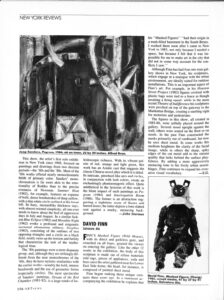ART NEWS, 1987
by John Sturman
This show, the artist’s first solo exhibition in New York since 1968, focused on paintings and drawings from two discrete periods—the ’60s and the ’80s. Most of the ’60s works offered nearly monochromatic fields of primary color. Sanders’ mono-chromatism is far more akin to the emotionality of Rothko than to the precise evenness of Newman. Summer Heat (1962), for example, features an expanse of bold, dense brushstrokes of deep yellow, with a thin white circle outlined at the lower left. Its hazy, mustardlike thickness says, with almost oriental simplicity, all one ever needs to know about the feel of oppressive days in July and August. In a similar fashion Blue Eclipse (1962) and Moonlite Night (1962) evoke a profound and enigmatic nocturnal ultramarine stillness. Sisyphus (1963), consisting of the outlines of two opposing triangles and a circle on a black field, neatly sums up the tension and futility that characterize the task of the mythological titan.
The ’80s paintings were a more disparate group, and, although they are strikingly different from the near monochromes of the ’60s, they do have stylistic similarities with the earlier works—notably the bold, intense brushwork and the use of geometric forms (especially circles). The most spectacular of Sanders’ paintings. Dream of the Red Chamber (1981-82), is a large tondo of kaleidoscopic richness. With its vibrant palette of red, orange and light green, this work has an Asiatic cast that suggests the classic Chinese novel after which it is titled. Its intricate, pinwheel-like arcs and circles, in conjunction with lush colors, create an enchantingly phantasmagoric effect. Quite antithetical to the lyricism of this work is the blunt impact of such paintings as Pogrom (1984) and Interrogation Room (1986). The former is an abstraction suggesting a nighttime scene of flames and barred doors; the latter depicts a lone slatted seat against a murky, menacing background.
ArtNews, March 1987, John Sturman


